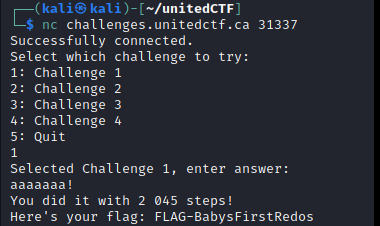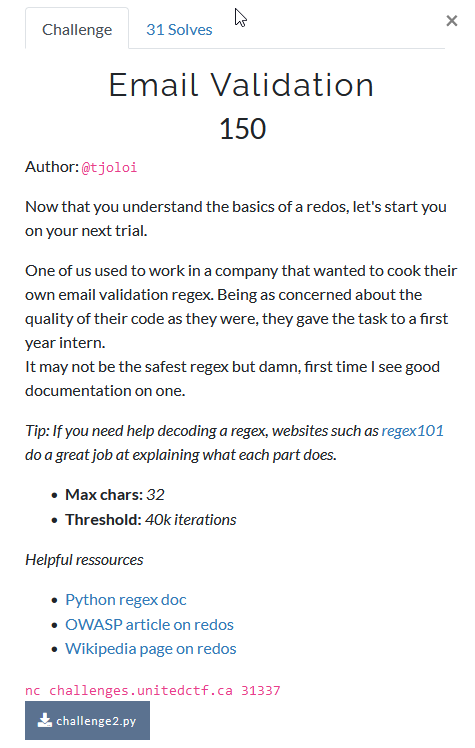UnitedCTF 2021 part 3: ReDoS
That track was very interesting for me because I didn’t knew what ReDoS was and it turns out it’s pretty powerful. So ReDoS means Regular expression Denial of Services. Basically there is some kind of algorithm that will try to match a string with the regular expression by evaluating all the possible paths. So you craft a string that will not match the regular expression but that will have a lot of possibility for the algorithm to explore.
Here is an example of a problematic regex, it must begin by a and end with a and the two plus will try to match themself repeatedly:
^(a+)+$
Using this string that we know won’t work since it doesn’t end with an A (and ! won’t match with an alphabetical character either so I’ll be reusing it in all my ReDoS) but nonetheless the algorithm will try every path before concluding there is no match:
aaaaaaaaaaaaaaaa!
I used the website regex 101, it’s very convenient and explain every part of the the regex. I usually find Regular expression hard to read and I do not tend to use them but it can be useful in some case like validating email and phone number. Turns out there is ReDoS in some default regex used for validation in ASP.NET MVC. Sounds interesting I’ll have to check this out sometimes… But back to the ReDoS tracks.
ReDoS 1: Introduction to ReDoS
So you are given a regex and you are told that you can only enter 8 characters in a console and you need to have more then 2000 iterations with the ReDoS. Here is the regex:
^(\w*)+$
And here is my first successful ReDoS:

ReDoS 2: email validation
This one was funny so I’ll just show you a picture of the challenge:

Reading the python script you realize that the intern has no idea what the regex he is working on is used for:
import re
regex = r'^(?P<firstWord>\w+)(?P<followingWords>\.\w+)*(?P<extention>\+\w+)?@(?P<subdomain>\w+)(?P<higherLevelDomains>.\w+)+$'
# firstWord: Match un premier "mot" [A-z0-9]
# followingWords: Comme beaucoup de monde mettent plusieurs mots séparés par un ., on tente d'en matcher plusieurs.
# extention: Dans notre dataset, j'ai vu des addresse qui ressemblaient à ça: addresse+unMot@exemple.com aucune idée de ce que ça fait, mais faut le supporter.
# subdomain: On doit avoir un domaine initial
# higherLevelDomains: Et avoir au moins 1 domaine de plus haut niveau (séparé par un . à chaque fois)
The regex in the code is slightly different then what I was used to. First the r means raw string and is meant so that python syntax doesn’t interfere with regular expression syntax. Then there is the (?P
a@a.aaaaaaaaaaaaaaaaaaaaaaaaaaa!
Anyway thank you intern!
ReDoS 3: Coding interview
From the challenge description we know it’s C++ source code. Here the python:
import re
msg = input()
r = r'^(?P<import_statement>#import)((?P<lib> m[a-z]l{2,10}((?<=l{2})oc))|.);(?(lib)[A-z =]*|[0-9])+$'
re.match(r, msg)
I remembered there was a library called malloc so I tried this payload and it worked beyond my expectation:

I needed to do 64 thousand iterations and I did more then a million!

Seeing those red messages warning of catastrophe made me proud but there were other easiest challenges that I wanted to try. Next up: QR and cats!